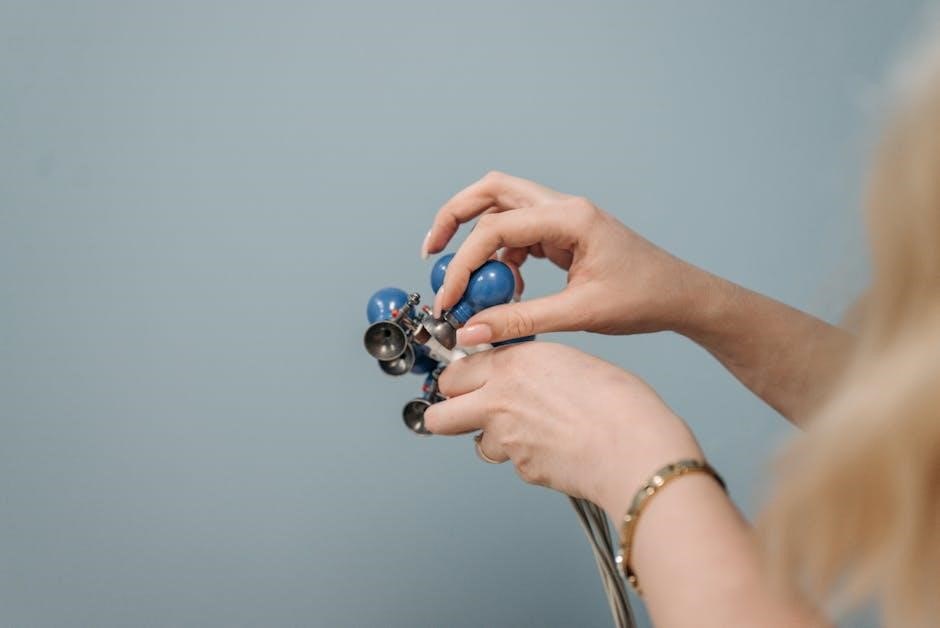Manual handling in aged care involves safely moving, lifting, or transferring residents to prevent injuries. Proper techniques are crucial to avoid musculoskeletal strain and ensure resident well-being. This practice is fundamental for caregivers, emphasizing safe work practices and the use of mechanical aids when necessary.

1.1. Definition and Relevance
Manual handling refers to the use of the body to move, lift, push, pull, or carry objects or people. In aged care, it is a critical component of daily operations, as caregivers frequently assist residents with mobility challenges. Proper manual handling techniques are essential to prevent injuries to both workers and residents, ensuring a safe and supportive care environment.

The relevance of manual handling in aged care cannot be overstated. Aged care workers often perform tasks that involve transferring residents from beds to chairs, assisting with personal care, or repositioning individuals to prevent pressure sores. Without proper training, these tasks can lead to musculoskeletal injuries, which are among the most common workplace injuries in the sector.

Manual handling is not just about physical techniques; it also involves assessing the environment, using mechanical aids when appropriate, and understanding the individual needs of residents. This holistic approach ensures that care is delivered safely and effectively, maintaining the dignity and well-being of aged care residents.
1.2. Importance in Aged Care Settings
Manual handling is a cornerstone of aged care, playing a vital role in maintaining the safety, dignity, and well-being of residents. In aged care settings, where residents often require physical assistance with mobility, transferring, and personal care, improper manual handling can lead to injuries for both residents and caregivers. According to recent data, approximately 25% of workplace injuries in Australia are linked to improper lifting techniques, making manual handling training indispensable.
The importance of manual handling in aged care extends beyond physical safety. It ensures that residents receive the care they need in a dignified and respectful manner. Proper techniques, combined with the use of mechanical aids, reduce the risk of musculoskeletal injuries among caregivers, fostering a safer and more sustainable workplace. Additionally, manual handling training empowers aged care workers with the skills and confidence to perform their duties effectively, enhancing the overall quality of care provided.

Why Manual Handling Certification is Essential
Manual handling certification is crucial for reducing workplace injuries, meeting legal requirements, and ensuring safe care practices. It equips workers with skills to handle tasks safely, minimizing risks for both caregivers and residents, while promoting a safer and more confident workforce in aged care settings.
2.1. Reducing Workplace Injuries
Manual handling certification plays a vital role in reducing workplace injuries, particularly in aged care settings where caregivers frequently lift, transfer, or reposition residents. According to recent data, approximately 25% of workplace injuries in Australia are attributed to improper lifting techniques, highlighting the urgent need for proper training. These injuries often result in musculoskeletal disorders, which can lead to long-term health issues for workers and decreased job productivity.
By completing a manual handling certification, aged care workers learn safe lifting techniques, how to use mechanical aids, and strategies to identify and mitigate hazards. This training not only protects workers but also ensures residents receive care safely and with dignity. Certification programs emphasize teamwork and proper posture, reducing the risk of strain and injury during manual tasks.
Additionally, certified workers are better equipped to handle emergency situations and provide consistent, high-quality care. This reduction in workplace injuries creates a safer environment for both staff and residents, fostering a more confident and effective caregiving team. In summary, manual handling certification is a proactive approach to minimizing risks and promoting overall well-being in aged care workplaces.
2.2. Legal Requirements for Aged Care Workers
In Australia, aged care workers are legally required to comply with Workplace Health and Safety (WHS) legislation, which mandates safe manual handling practices. Employers must ensure that staff are adequately trained to perform manual tasks safely, and employees must follow established safety protocols. Failure to meet these requirements can result in penalties, fines, or legal action against both the employer and the worker.
Manual handling certification is a legal necessity for aged care workers, as it demonstrates compliance with WHS regulations. The certification process typically involves completing a nationally recognized training module, such as HLTWHS005 – Conduct Manual Tasks Safely. This module equips workers with the knowledge and skills needed to identify risks, use proper lifting techniques, and implement control measures to prevent injuries.
Additionally, the Australian Skills Quality Authority (ASQA) oversees the standards for manual handling training, ensuring that courses meet legal and industry requirements. Employers are required to provide ongoing training and updates to maintain compliance with changing regulations. By adhering to these legal standards, aged care facilities can create a safer work environment and reduce the risk of workplace injuries.
Overall, manual handling certification is not just a best practice but a legal obligation for aged care workers, ensuring they can perform their duties safely and effectively while meeting regulatory requirements.

Course Content and Structure
Manual handling courses for aged care cover essential techniques for safe lifting, transferring, and handling residents. Modules include hazard identification, proper posture, and the use of mechanical aids. Training is delivered through interactive online platforms, with flexible durations to suit learner needs, ensuring practical skills for real-world application;

3.1. Key Modules in Manual Handling Training
Manual handling training for aged care typically includes modules on hazard identification, safe lifting techniques, and the proper use of mechanical aids. Participants learn how to assess risks associated with manual tasks and implement control measures to minimize injuries. The training also covers ergonomics, posture, and teamwork strategies to ensure safe resident transfers. Practical demonstrations and case studies are often incorporated to reinforce theoretical knowledge. Additionally, modules may address specific scenarios, such as transferring residents with mobility challenges or using equipment like hoists and slide sheets. The curriculum emphasizes adherence to workplace health and safety standards while promoting a culture of safety and accountability. By mastering these modules, aged care workers gain the skills and confidence to perform manual handling tasks effectively, reducing the risk of injury to both themselves and their clients. The training concludes with assessments to ensure competency, preparing participants to apply their knowledge in real-world care settings. These modules are essential for maintaining a safe and efficient aged care environment. Proper training ensures that workers can handle manual tasks safely and efficiently, reducing the risk of workplace injuries and improving overall care quality.
3.2. Duration and Delivery Methods
Manual handling training for aged care workers is designed to be flexible and accessible, with varying durations to suit different learning needs. Some courses are as short as 12 minutes, focusing on essential techniques, while others may take several hours to cover comprehensive material. Online platforms offer self-paced learning, allowing participants to complete modules at their convenience. In-person sessions, often conducted in workplaces, provide hands-on practice and group interaction. Many programs combine theoretical knowledge with practical demonstrations, ensuring learners can apply their skills effectively.
Interactive elements, such as animated videos, quizzes, and case studies, enhance engagement and understanding. Some providers offer modular training, where learners can complete shorter sessions over time. This flexibility is particularly beneficial for aged care workers with demanding schedules. Upon finishing all modules and assessments, participants typically receive a certificate of completion. The training is structured to accommodate both individual and group learning, ensuring that all workers can access the knowledge and skills needed to perform manual handling tasks safely and effectively. This approach supports continuous improvement in workplace safety and care quality. By offering varied delivery methods, manual handling training ensures that aged care workers can gain the necessary competencies without disrupting their critical roles in resident care.

Benefits of Manual Handling Training
Manual handling training enhances workplace safety, reducing injuries for healthcare workers and improving care quality for aged care residents. It equips workers with essential skills to perform tasks safely, promoting a safer work environment and better resident outcomes. This certification is nationally recognized, ensuring compliance and competence in care settings.
4.1. Enhanced Safety for Healthcare Workers
Manual handling training significantly enhances safety for healthcare workers by equipping them with the skills to perform tasks safely. Proper lifting techniques, hazard identification, and the use of mechanical aids reduce the risk of musculoskeletal injuries, which are prevalent in aged care settings. Workers learn how to maintain proper posture, assess tasks for potential risks, and use equipment effectively to minimize strain. This training fosters a safer work environment, reducing absenteeism and workplace injuries. Additionally, it promotes a culture of safety, encouraging workers to prioritize their well-being and that of their colleagues. By mastering manual handling practices, healthcare workers can confidently perform their duties, knowing they are protected from preventable harm. This certification ensures compliance with workplace safety standards, further safeguarding employees and residents alike. The focus on practical, real-world applications makes the training highly effective in reducing injury rates and improving overall workplace safety. Ultimately, manual handling training is a critical investment in the health and longevity of aged care workers, enabling them to provide quality care without compromising their own safety.
4.2. Improved Care for Aged Care Residents
Manual handling training directly enhances the quality of care provided to aged care residents by minimizing the risk of injury during transfers and movements. Proper lifting techniques and the use of mechanical aids ensure residents are handled with dignity and comfort, reducing the likelihood of falls or strains. This training also fosters a safer environment, allowing residents to maintain their independence and mobility without unnecessary risks. By mastering safe manual handling practices, caregivers can better meet the individual needs of residents, ensuring their physical well-being and emotional comfort. Additionally, the use of personalized care plans and visual handling charts tailored to each resident’s requirements further improves safety and efficiency. These tools help caregivers identify the most appropriate methods for assisting each resident, reducing the risk of accidents and ensuring consistent, high-quality care. The overall goal of manual handling training is to create a safer, more compassionate environment where residents receive the support they need while maintaining their dignity. This approach not only benefits residents but also contributes to a positive workplace culture, where staff feel confident in their ability to provide exceptional care. By prioritizing safe manual handling, aged care facilities can ensure residents receive the highest standard of support and attention.

Obtaining the Manual Handling Certificate
Enroll in recognized manual handling courses designed for aged care workers. Complete interactive online modules, pass quizzes, and finish within 3 hours. Upon completion, receive a nationally recognized certificate, ensuring compliance with workplace safety standards and enhancing your caregiving skills effectively.

5.1. Enrollment Process and Requirements
Enrolling in a manual handling certificate course for aged care is straightforward and accessible. Most courses are offered online, allowing flexibility for workers to complete training at their convenience. To enroll, participants typically need to visit the training provider’s website, such as info@tu.edu.au or OHS.com.au, and follow the registration process. No prior qualifications are required, making it suitable for all aged care staff, including nurses, support workers, and volunteers.
Once enrolled, participants gain access to interactive modules designed by industry experts. These modules cover essential manual handling techniques, hazard identification, and the use of mechanical aids. The course duration varies but typically ranges from 3 to 12 hours, depending on the provider. For example, Auscare’s HLTWHS005 Conduct Manual Tasks Safely course can be completed in approximately 3 hours, while others may offer shorter or longer formats.
To successfully complete the course, participants must finish all modules and pass a knowledge assessment, which may include quizzes or practical demonstrations. Upon completion, a nationally recognized certificate is issued, such as the HLTWHS005 certification, ensuring compliance with workplace safety standards. This certification is valid for a specified period and may require renewal to maintain up-to-date skills and knowledge.
For more information or to enroll, contact providers like OShea Manual Handling Training or First Aid Pro, which offers courses tailored to aged care workers. Their programs are designed to enhance safety and care quality, making them an essential step for anyone working in the aged care sector.
